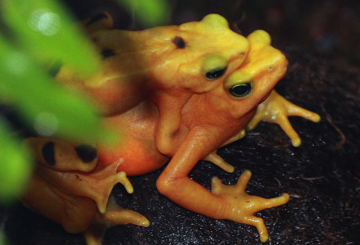Mass amphibian die-offs affect ecosystems
mongabay.com
October 18, 2008
|
|
Large-scale die-offs of amphibians due to the outbreak of a killer fungal disease is impacting the forest ecosystem in which they live, reports a new study published in the journal Ecosystems.
Researchers from the University of Georgia have for the first time documented the impact of the disappearance of tadpoles from habitats in Central America. They found that without tadpoles stirring up the sediment of streambeds, algae were less productive at converting sunlight into food for the rest of the biological community. Because algae serves as the base of the aquatic food chain in these habitats, the decline in productivity is ecologically significant.
“Many things that live in the stream depend on algae as a base food resource,” said lead author Scott Connelly of UGA. “And we found that the system was more productive when the tadpoles were there.”
“We were there before, during and after the extinction event and were able to look at the ecosystem and measure how it changed,” added Catherine Pringle, a UGA professor of ecology and a co-author of the study. “Very rarely have scientists been able to do that with respect to any organism.”
 A casualty of chytrid? Panama’s golden frog (Atelopus zetecki), a species that may now be extinct in the wild due to Chytridiomycosis. In many parts of Panama this frog — actually a species of harlequin toad — is considered a good luck charm and was once collected from the wild by people to put in their homes. Panama golden frogs mating in captivity. Photo by Rhett A. Butler |
The researchers also demonstrated declines in populations of frog-predators, like snakes. Other studies in Central America have also shown significant changes in the species composition of habitats following the disappearance of frogs.
The chytrid fungus is decimating amphibians populations around the world. While the drivers of its emergence and spread are hotly debated — climate change and spread by accidental human introduction of the pathogen to habitats are the leading theories — the disease kills up to 90 percent of amphibians when it enters an ecosystem. The extinction of more than 100 species of amphibian have been linked to the pathogen over the past 20 years and scientists are taking urgent measures to save the most affected species via ex-situ (i.e. captive breeding) conservation programs.
“Once the frogs die, it’s like an incredible silence descends over the whole area,” said Pringle, referring to the streams the researchers are monitoring. “It’s eerie.”
“The one speck of hope is that if we’re able to collect some of these rare animals, we can cure them,” added Connelly. “As long as we have the money to keep a breeding program going, in the future it might be possible to reintroduce them into the wild.”
Conservationists aim to raise more than $400 million by 2012 to help save endangered amphibians and their habitats. One project, the Amphibian Ark, seeks to establish captive breeding programs for the 500 species that are most at risk. Overall about one third the world’s 6,100 species of amphibians are threatened with extinction.
RELATED ARTICLES
Armageddon for amphibians? Frog-killing disease jumps Panama Canal October 12, 2008
Chytridiomycosis — a fungal disease that is wiping out amphibians around the world — has jumped across the Panama Canal, report scientists writing in the journal EcoHealth. The news is a worrying development for Panama’s rich biodiversity of amphibians east of the canal.